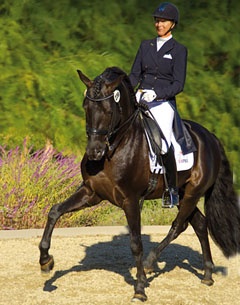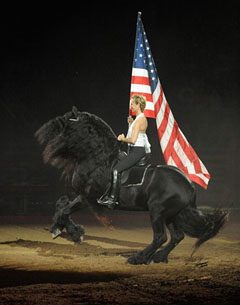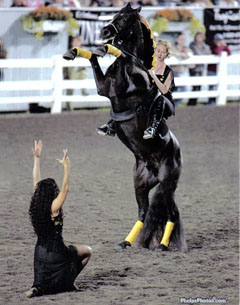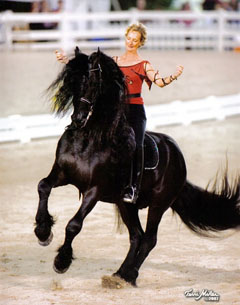
As a dressage trainer and competitor, Sabine Schut-Kery is not afraid to wear different hats--or ball gowns if the job calls for it. In the United States, where she is now a citizen, Sabine is known for everything from topping the Young Horse Championships and winning at FEI levels in Burbank and Wellington, to dancing flamenco on horseback, and even a mounted presentation of the US flag at the World Cup in Las Vegas--all done with her own inimitable style. Sabine enjoys her exhibition work as much as formal competition, and to both she brings a level of skill and sensitivity rarely seen in America.
When it comes to her favorite breed, Sabine is also hard to pin down. While training and showing many warmbloods with national success, she also has been long associated with "alternate breeds". Sabine grew up training Friesians in Germany. Following her move to America, Sabine worked with a Friesian breeder and competed two of their stallions successfully up the levels through Grand Prix. Additionally, Sabine has always loved and worked with the PRE horse. In California, where she lives with her husband, Hollywood stuntman Kristian Kery, Sabine regularly trains PRE horses in her program.
One horse, Marques XXXVI, is a standout from the rest, and looks to be the one that might take her back into the spotlight of the International arena. Together they have been receiving scores as high as 79% this year at the national Prix St. George and Developing Horse classes. They are the 2013 Horse of the Year at Prix St. George for the United States Dressage Federation, with a median score of 74.09%, and have been invited to participate in clinics with US Developing Dressage Coach Debbie McDonald. Last month they were officially recognized by the Developing Dressage Program as a combination demonstrating “great potential for the future of dressage in the United States”.
USPRE--the national Association of PRE breeders in the United States-- is a sponsor of Sabine and Marques and recently had a chance to interview her about the horse, her training, and her thoughts on Marques and PREs in general for American dressage.
 USPRE: Please tell us about Marques and how he came into your life.
USPRE: Please tell us about Marques and how he came into your life.
Schut-Kery: Marques (Selecto VI x Airoso XXVI) is a 2004 black approved stallion bred by Alba Vargas from strong Escalera performance bloodlines. Rhea Scott (Marques’ owner) discovered him while on vacation at the Epona Equestrian Center in the south of Spain. She imported him to the U.S. to be her personal riding horse and was looking for the right trainer. She wanted someone who had experience with the breed and training stallions when, luckily, I was recommended to her by a friend.
When Marques first came to me, the plan was to train him for a personal riding horse for Rhea and a horse that I could also use in exhibitions. Julie Ronning (my assistant) and I worked with Marques for about seven months, when we began to see his potential as a dressage competition horse. I showed him to my coach Christine Traurig, and his talent impressed her too. Rhea was just as excited about his abilities and we made a new plan. We formed a partnership on Marques so that I could train and compete him and we went back to Spain and found Rhea a new riding horse. We did have a big setback when Marques developed a painful inguinal hernia, which required surgery. It kept us on the sidelines for about 18 months all together.
USPRE: What has been your training approach with this horse, as compared to other horses that you have trained? Do you work with a trainer yourself?
Schut-Kery: Yes, I work with Christine Traurig on a regular basis. She has an amazing eye and is very detailed in her riding and coaching. In addition I also work with Debbie McDonald.
My training approach for Marques is the same as with the warmbloods. I like all my horses to be sensitive and sensible. A lot of my training is focused on improving the gaits and getting the horse to respond correctly to my aids. I strive to build a relationship between my horse and me, wherein we understand and communicate easily with each other and with the smallest aids possible.
USPRE: Tell us what makes Marques special. What is he like to work with?
Schut-Kery: Marques is such a pleasure to work with, because he has a great work ethic and ride-ability. He is a very honest horse, and I think this quality is one of the highlights of the Spanish horse. He has competitive gaits and a good hind end that can push! I think we see a lot of Spanish horses with good carrying power but not always enough pushing power. Marques has become a responsive horse that is light to the aids. He is still a stallion, and he was used for breeding in Spain. He has a good amount of stallion behavior and can get distracted at times, but I have to say – so far – when it is important and I need him to focus, he does!
USPRE: You have achieved outstanding scores in the Prix St. George and Developing Horse tests this year. In addition to multiple wins and regional championships together, you are currently in first place (out of 417) for USDF Horse of the Year at PSG with an average of 74.079%. Achieving these kinds of marks at the Small Tour levels are typically more difficult for Iberian horses. What do you attribute your success to?
Schut-Kery: Marques’ gaits are competitive. He has scope and "Schwung" in his movement and a really good hind leg that can work into his body and can push. In addition, he rarely makes technical mistakes in his tests.
 USPRE: Why did you decide not to compete in the Young Horse Championships at Lamplight this year? Is there a strategy behind your decision to hold off showing him in the international classes?
USPRE: Why did you decide not to compete in the Young Horse Championships at Lamplight this year? Is there a strategy behind your decision to hold off showing him in the international classes?
Schut-Kery: My long-term goal is to compete him at Grand Prix, and I didn't think the Young Horse Championships were necessary for his becoming a Grand Prix horse. I am trying to avoid putting any extra stress on him.
No there is no strategy, I had to deal with ulcers that he had developed from the inguinal hernia and a quarter crack both in the spring during the CDI shows, just bad timing . My first show with him this year was in April and in May I did Flintridge. I really wanted to know if he was competitive in the Developing Prix St. George at a show like Flintridge that served as the western selection trials for the young horse program. After Flintridge I applied quickly to get into the developing clinic with Debbie McDonald and she said to focus on getting him to Grand Prix.
USPRE: What are your plans for moving the horse up to Grand Prix? Have you set your sites on WEG 2014?
Schut-Kery: We are working on the Grand Prix movements and to strengthen him for that caliber of work. Marques already has a beautiful piaffe and passage, and we are schooling the one-tempi changes.
WEG is not a realistic goal for us because Marques has not shown yet at Grand Prix. The horses that represent our country have to get exposure and compete in Europe against the top European horses. At this point we don’t have enough time to accomplish that.
USPRE: What other horses do you have in training? Now that you are an American citizen, do you have hopes to represent the United States one day on the US team?
Schut-Kery: Yes, it is my dream and goal to represent the United States in international competitions, especially now that I have two horses that have potential.
In addition to Marques, I have a very promising 7 year old Hanoverian stallion named Sanceo that I started training since the age of three., owned by Alice & Mike Womble-Heitman of Horsegate Ranch. Last year, as a 6 year old we represented the US in the Young Horse World Championships in Verden, Germany and I am planning to compete next year in the PSG developing program. I also have another 9 year old talented PRE, Tardon, owned by Margaret Carrera and Phil Joffe of Symphony Farms, with whom I won the USDF Region 7 Championships at Prix St George level last year. He is coming back from a small injury and I am focusing on showing him at I-2 and eventually Grand Prix.
 I especially love the process and challenge of taking a horse from a very young age and training it through the levels. I am fascinated by the bond and partnership that I can build over the years with a horse that I have trained from a young age. So the process is fun and important to me. I am in control over the development of the horse, and for the rest, all I can hope for is that the stars are aligned in the right place, at the right time.
I especially love the process and challenge of taking a horse from a very young age and training it through the levels. I am fascinated by the bond and partnership that I can build over the years with a horse that I have trained from a young age. So the process is fun and important to me. I am in control over the development of the horse, and for the rest, all I can hope for is that the stars are aligned in the right place, at the right time.
USPRE: In a recent interview with USPRE, US Chef d'Equipe Robert Dover has invited the best of the PRE breed to aspire to team competition in the US. What do you feel the prospects are for PRE horses in the United States and on the world stage in the future? What, in your opinion, needs to happen before more PRE horses will be seen in the international arenas?
Schut-Kery: Breeders and trainers need to connect more about what kind of horse it takes to be competitive in dressage. Ride-ability and trainability are extremely important qualities (besides three good gaits) that determine which horses will be successful in the competition ring. Breeders need to try to sell or place their offspring with riders who can provide the quality of training that brings out the best in each horse.
It would also be great if breeders would educate themselves by attending more international competitions to see what kind of horse it takes today to be competitive and successful in the competition ring. It would be great if breeders would follow the careers of their offspring, in order to get feedback about strengths and weaknesses of their breeding program.
I think we need to produce more PRE horses that have scope in their gaits and the presence necessary to fill up a 20 by 60 meter dressage arena. They already have great expression and brilliant talent for piaffe and passage. With these qualities combined, plus correct training, the PRE horse will be a valuable asset to any team.